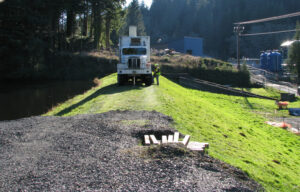In 1928, the St. Francis Dam in California failed, resulting in the loss of hundreds of lives and the passage of dam safety laws in several states, including Oregon. Over the years, however, the resources dedicated to dam safety have been limited, and challenges in ensuring their safety remain. Engineering standards have evolved over time, as has our understanding of seismic and flood risks, demanding new actions and programs. These challenges are compounded by the fact that dams are aging, with some showing signs of degradation or requiring urgent repairs.
These challenges are not unique to Oregon, and in the past 5 years, the failure of over 100 dams in North and South Carolina during extreme flooding and the safety incident at California’s Oroville Dam have demonstrated their urgency. Recently, the State of Oregon has increased its focus on improving the safety of dams under its jurisdiction, recognizing that actions must be taken to address dam safety deficiencies in order to prevent the loss of life and damage to property from a dam failure and to preserve the many benefits that dams provide for our communities and economy.
The Oregon Water Resources Department (WRD) is the state agency charged with overseeing the safety of approximately 950 dams in Oregon that store water for agriculture, cities, industry, recreation, fisheries, and other purposes. Of these dams, 76 are rated as high hazard, meaning that the loss of human life would be expected should the dam fail, while another 151 are rated significant hazard, meaning failure is likely to result in damage to property or infrastructure, but not the loss of life. The hazard rating reflects the expected results of failure, not the condition of the dam.
In 2018, the Oregon WRD began an effort to modernize Oregon’s dam safety statutes, which had remained virtually unchanged since 1929. In 2019, the Oregon legislature passed House Bill 2085, providing a policy foundation and additional tools for the department to address dam maintenance and safety issues. Among other features, the bill provides the department with the authority to work cooperatively with dam owners to address safety issues prior to engaging in a more traditional enforcement approach. The cooperative approach was proposed in recognition of the time and expense required to repair, replace, or rehabilitate a dam and the fact that lack of funding can be a significant barrier to these efforts.

Visual inspections are the primary tool and approach the department employs to identify potential deficiencies. Oregon seeks to inspect high-hazard dams annually, and significanthazard dams every few years. Of the 76 dams rated high hazard, 20 are in poor or unsatisfactory condition based on current information available to the department.
As resources allow, the department has conducted risk assessments or analyses of dams for certain vulnerabilities, but the reality is that funding has been insufficient for decades. Significant federal funding for the inspection of nonfederal dams was provided after a series of dam failures in the 1970s. In Oregon, these federal dollars bolstered engineering staff working on dam safety, improving the ability of the department to evaluate dam safety deficiencies. The effort, however, was temporary, as federal funding for the effort waned. With minimal funding resources, the department has been able to do only partial risk assessments of dams; full risk assessments of stateregulated dams have not been completed in decades, even as engineering standards and the understanding of risks to dams have advanced.
Now that the state has a strong policy foundation, the department is turning its attention toward obtaining resources to conduct more detailed assessments of the risks to dams, including funding for more in-depth analyses, where needed; identifying approaches to prioritizing dams for repair, rehabilitation, or replacement; and identifying funding resources for addressing dam safety issues.
To that end, the department applied for and was awarded funding from the Federal Emergency Management Agency’s High-Hazard Potential Dam Rehabilitation Grant, which will help it conduct risk assessments of 16 high-hazard dams and take steps to help dams in the state meet the criteria for future funding. The program’s current funding, however, is small in comparison to its needs, and future federal authorizations will need to be increased greatly if the goal is to make meaningful progress on safety issues.
The State of Oregon is also providing funding to improve the safety of dams, with the Oregon Legislature allocating $14 million in 2019 to address the long-standing safety issues of Wallowa Lake Dam, which were identified in the 1980s. The Oregon legislature also authorized $4 million to support efforts to begin to address the seismic deficiencies discovered in the past decade, as well as recent and increasing seepage at the City of Newport’s dams. The City of Newport has been aggressively seeking out other funding sources. The city and state have noted the challenges of finding funding to address dam safety issues.
The funding provided by the state is a good first step, but much work remains, and the funding gap is significant. As such, Oregon Governor Kate Brown is introducing legislation for the 2020 legislative session to provide $2 million to the department to conduct risk assessments at additional high-hazard dams and to fund more in-depth analyses. The legislation will also establish a dam safety task force that will make recommendations on how to prioritize dam safety projects and identify potential funding mechanisms. These efforts will help the state determine how to most effectively direct its limited resources and will complement the governor’s 100-Year Water Vision as well as the state’s resiliency efforts.
Racquel Rancier is a policy manager at the Oregon Water Resources Department. She can be contacted at racquel.r.rancier@oregon.gov.
